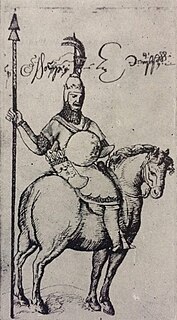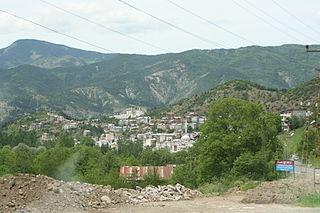Giorgi III Gurieli, of the Georgian House of Gurieli, was Prince of Guria from 1669 to 1684 and King of Imereti from 1681 to 1683. He was energetically involved in civil wars in western Georgian polities, which he sought to bring under his sway. He was killed in battle while trying to recover the lost throne of Imereti.

Mamia III Gurieli, also known as Mamia the Great Gurieli or the Black Gurieli, of the western Georgian House of Gurieli, was Prince of Guria from 1689 to 1714. Involved in civil wars plaguing western Georgia, he became King of Imereti three times in the years of 1701, 1711–1712, and 1713–1714. After his first reign as king for a year in 1701, he abdicated the throne of Imereti, being unable to tolerate the influence of his father-in-law Giorgi Abashidze. Subsequent periods of his royal career was the result of a feud with Giorgi VII of Imereti. Mamia died while still sitting on the throne of Imereti, which then reverted to his rival Giorgi VII.
Giorgi IV Gurieli, of the House of Gurieli, was Prince of Guria from 1711 to 1726, and a king of Imereti in western Georgia in 1716. He was installed as regent of Guria by his father, Mamia III Gurieli, then the king of Imereti, in 1712. In 1716, he seized the crown of Imereti, but was forced to abandon the enterprise later that year. Returning to Guria, his rule was challenged by a faction of local nobility, which included his mother Elene and brother Kaikhosro III Gurieli. He was finally able to crush the opposition after making peace with Bezhan Dadiani, Prince of Mingrelia.
Demetre Gurieli, of the House of Gurieli, was Prince of Guria from 1658 to 1668 and King of Imereti from 1663 to 1664. His rule in Guria as well as in Imereti were result of coups and part of a chaotic civil war raging in these western Georgian polities. Demetre's royal career in Imereti terminated with his deposition and blinding.
Ivane Abashidze was a Georgian nobleman of the Abashidze family and a claimant to the throne of Imereti during the revolt against the Russian rule in 1820. He was murdered in exile in the Ottoman Empire.
Liparit III Dadiani was Prince of Mingrelia, of the House of Dadiani, from 1657 until being deposed in 1658.
Bezhan Dadiani, of the House of Dadiani, was Prince of Mingrelia from 1715 to 1728. He acceded to power in a coup against his own father, Giorgi IV Dadiani, and came to dominate western Georgian politics by asserting tutelage over King Alexander V of Imereti until being murdered by Ottoman agents.
Rostom Gurieli, of the House of Gurieli, was Prince of Guria from 1534 until his death in 1564. Alongside his royal suzerain, Bagrat III of Imereti, Rostom fought against the expanding Ottoman Empire to which he lost parts of his principality. Rostom's relations with Bagrat III subsequently deteriorated over his support to the king's defiant vassal, Levan I Dadiani.
Giorgi II Gurieli, of the House of Gurieli, was Prince of Guria from 1564 to 1583 and again from 1587 to 1600. Succeeding on the death of his father Rostom Gurieli, Giorgi's rule over his small principality, located in southwest Georgia, was a period of conflict with the neighboring Dadiani of Mingrelia and increasing assertiveness of the Ottomans whom Gurieli submitted in 1581. His reign was interrupted, from 1583 to 1587, by a Mingrelian invasion, but Giorgi was able to resume the throne with Ottoman support.
Vakhtang I Gurieli, of the House of Gurieli, was Prince of Guria from 1583 to 1587. He ruled Guria, a small state in southwestern Georgia, as a client of Mamia IV Dadiani, Prince of Mingrelia, who had deposed Giorgi II Gurieli. Vakhtang was one of the sponsors of the Shemokmedi Monastery, Guria's principal cathedral.
Mamia II Gurieli, of the House of Gurieli, was Prince of Guria from 1600 until his death at the hands of his own son Simon in 1625. Mamia's rule over his small principality, located in southwest Georgia, saw efforts to rebuff encroachments of the Ottoman Empire, with which he was forced to make peace in 1614, conceding the loss of territories and placing Guria under the obligation of paying tribute.
Kaikhosro I Gurieli, of the House of Gurieli, was Prince of Guria from 1626 to 1658. He was installed by Levan II Dadiani, Prince of Mingrelia, in place of his deposed predecessor Simon I Gurieli. In his turn, Kaikhosro was overthrown and expelled by King Alexander III of Imereti. His comeback to Guria, in an Ottoman-supported endeavor, concluded with his assassination by a Gurian nobleman.
Malakia Gurieli, of the Georgian House of Gurieli, was Prince of Guria from 1684 to 1685 and again in 1689. A younger son of Kaikhosro I Gurieli, he succeeded on the death of his brother Giorgi III Gurieli in 1684, only to be overthrown and blinded by his nephew Kaikhosro II Gurieli. Briefly restored through the Ottoman intervention in 1689, he was deposed by Guria's nobility for incompetence. Malakia entered the priesthood and became Bishop of Shemokmedi.

Kaikhosro III Gurieli was a member of the Georgian family of Gurieli, a princely dynasty of Guria. He was briefly Prince-regnant of Guria as a rival to his brother Giorgi IV Gurieli in 1716. In 1724, he emigrated to the Russian Empire, where he commanded the Georgian Hussar Regiment in the 1740s.
Mamia IV Gurieli, of the western Georgian House of Gurieli, was Prince of Guria from 1726 to 1756 and again from 1758 to 1765 and from 1771 to 1776. Intermissions of his rule was the result of Mamia's rivalry with his younger brother, Giorgi V Gurieli, and complex political situation in the region, including the Ottoman encroachments and efforts by the kings of Imereti to bring western Georgian polities under their supreme authority.
Giorgi V Gurieli, of the western Georgian House of Gurieli, was Prince of Guria from 1756 to 1758 and again from 1765 to 1771 and from 1776 to 1788.
Vakhtang II Gurieli, of the House of Gurieli, was Prince of Guria, in western Georgia, from 1792 to 1797. He succeeded on the death of his elder brother Simon II Gurieli and was deposed by a younger brother Kaikhosro. Vakhtang's subsequent efforts to regain power were futile.
Kaikhosro IV Gurieli was a member of the House of Gurieli, a ruling dynasty of the Principality of Guria in western Georgia, which he de facto ruled as regent for his underage nephew Mamia V Gurieli from 1797 to 1809. An energetic and learned man, he presided over a series of measures which brought relative order and stability to Guria. Kaikhosro remained influential even after conceding ruling powers to Mamia V in 1809. Despite rapprochement with the Russian Empire, Kaikhosro was suspicious of the Russian intentions. While Mamia remained loyal to Russia, Kaikhosro became involved in an uprising against the Russian hegemony in western Georgia in 1820. After the rebels' defeat, Kaikhosro had to flee to the Ottoman territory, where he died in 1829.
The 1703 Ottoman invasion of western Georgia was a military expedition undertaken by the Ottoman Empire against the tributary states in western Georgia—Imereti, Guria, and Mingrelia. This considerable military deployment, ostensibly to settle a power struggle in Imereti in favor of the sultan's candidate, portended a change in Ottoman policy in the fluid frontier region in the Caucasus and aimed at consolidating the imperial authority among the restive Georgian subjects. The costly war contributed to the fall of Sultan Mustafa II, having incited a mutiny of the disaffected troops at Constantinople. The new Ottoman government curtailed the campaign and effected withdrawal from much of western Georgia's interior. The Turks held the Black Sea coastline and several fortresses close to the littoral.





